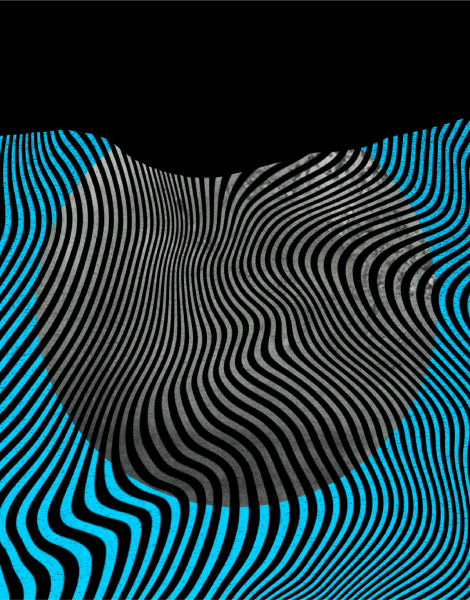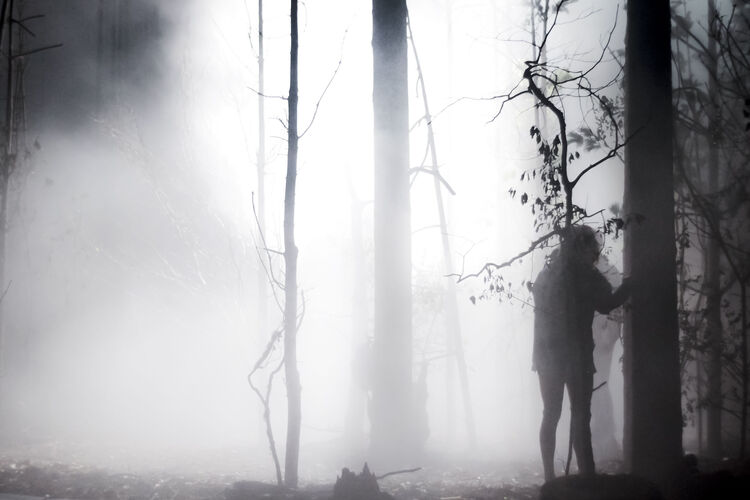Questo articolo è disponibile anche in:
Italiano
#07
Orecchio acerbo
Radio, podcast, educazione
a cura di Ilaria Cecchinato e Rodolfo Sacchettini
Sounds adventures with little detectives: the Sara’s Mysteries podcast series
Interview with the author Sara de Monchy
by Ilaria Cecchinato
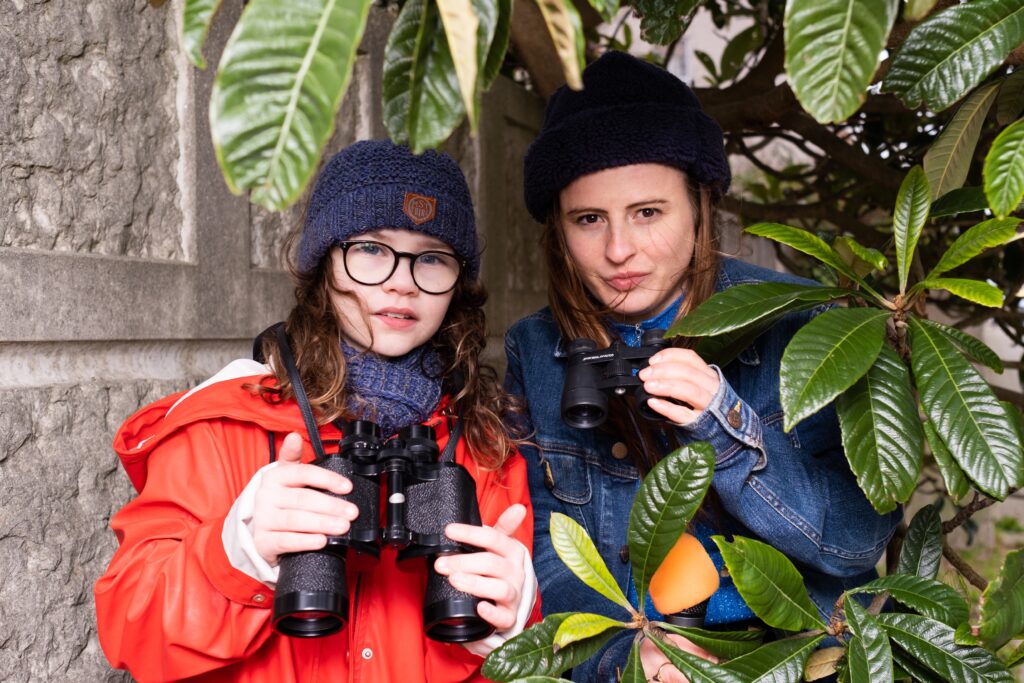
All of us, at least once, have been faced with a mystery to solve: whether this is big or small, the solution is not always just around the corner and, although looking for clues involves a certain amount of effort, it can also be a lot of fun. Telling us about mysteries and other oddities is Sara de Monchy, Dutch theatre director and audio maker, author of a successful podcast in the Netherlands, Sara’s Mysteries, an artistic project aimed at and created with children. Through the invisible art of podcasting – both as a practice and a product – Sara’s Mysteries intends to light up the imagination and fantasy of the kids, stimulating their critical thinking and deep reflections on major issues. On each episode, dedicated to a young protagonist and his or her own mystery to solve, Sara leads the child and listeners on an adventurous journey in search for an answer .
Ilaria: How did the idea of Sara’s Mysteries come about and why did you decide to make audio for children in your artistic career?
Sara: I studied direction at the Royal Theatre Academy (Maastricht) and I had some trouble making sets. So I felt that creating audio works was much better for me because the audience can imagine for themselves the world I tell. When I thought about this, it occurred to me that as a child I preferred reading a book instead of watching a film, because I could fantasize. For example, I really love the Harry Potter’s saga, watching the movies after I read the books is still disappointing for me because they were so different from what I imagined. I also remember being fascinated by stories to listen to, those from sound books with sound design and compositions in it. I loved them so much: I used to sit in front of the music box in the living room half-stretched and while I was listening I used to roll my eyes as if I entered completely into the world of the stories. Those strong memories brought me to the decision to make audio for children. I applied to a program in the Netherlands organized by the International Documentary Festival, a huge event that had a program for young documentary makers like the Public Broadcaster for children (here we have three good channels dedicated to kids financed by the government). That year for the first time there was also an audio trial and I thought it was an opportunity for me to indulge my love of imagination. So I applied, but with a different idea from Sara’s Mysteries: they said to come up with another project because that one hasn’t been good enough yet to become a real program to be financed. I had so many things in my head and I realized that what I really wanted was to create something for children, but instead of me thinking about a theme, I decided that the children should create their own themes. Then I went to a school to give a little workshop. I didn’t have the word “mystery” yet, but at the end, I asked the kids if there was something that people would solve in their lives: fifteen hands rich in the air. This is how Sara’s Mysteries began.
Ilaria: In this sense, “mystery” is a theme and at the same time a practice, a way of involving children in a sort of game. Is there an educational value in this process? What kind of relationship do you establish as an adult with children and vice versa?
Sara: That is a good question and also a hard one because I feel that in my relationship with children, the educational aspect is not something I really focus on. For them I am a kind of big cool sister, part of their team. In this sense, I have a totally different relationship with them than their teachers or their parents. I think that they are so involved because I really listen to them, taking what they tell me seriously. I always try not to fill in the answers: for example, sometimes they ask me a question they think I know the answer to. I ask them instead: “what do you think?” or “what do you think we should do?”. In this way, I don’t see myself as an educator, but I am always focused on my relationship with the kid .
Ilaria: You are bringing back in my mind what you explained during your masterclass at Lucia Festival. You said that you do not stand in front of the children but sit next to them as you are playing together with Lego construction. It is a really interesting image and now I see it more clearly. I think that even if it is not the primary intent, there is already some form of education in this type of relationship…
Sara: I think that the educational aspect is mostly learning for growth. During the creation process, there is something similar. We start looking at the subject of the episode and then we try to see it in another way. In the end, we talk about big themes related to the main matter, for example, racism or the choices of people in World War II. This could be intended as a sort of education, but I think that the learning comes out when the podcast is finished and people listen to it. However, when I create together with children , I don’t focus too much on teaching something or on the educational level of the process, because I think this might hinder the imagination.
Ilaria: Entering the heart of the creation process, what are your work steps? Where do you start from and how do you develop every episode? Your podcast is popular in the Netherlands, but I suppose that at the beginning it was quite difficult to explain to the children what they were going to do. How did you approach them before and how do you approach them now?
Sara: It is true what you said: now Sara’s Mysteries is more famous, but to be honest, the best children are those who don’t know anything about the podcast because they come with the most authentic mysteries. They can make an original and spontaneous story instead of thinking of one that could be adapted to the format or to what another child did in other episodes. My inbox is getting full of children who have mailed me with their mysteries, but sadly, what I find out is that most of those kids have already had a picture in their heads of what it should be. So, first I go to schools to find children to include and there I give a workshop for free. In the end, I ask the class if anybody has a mystery: usually, at least fifteen hands are raised. Afterward, I speak individually with each of them, outside the classroom around a small table. With whom I want to talk longer I organize a Zoom call, then I come to my office asking myself if there are bigger themes I can connect to and if the mystery is solvable. Then I make a plan with the child, thinking together about how to solve each step of the mystery and planning the next moves, like searching for something on the internet, doing an interview, or going to a specific place. So we have a sort of brainstorming and after that, I create the structure. At this point, I tell the parents I would come three to five times to their house. The child gives cues we try to incorporate them into the planning I have created: in this way it is really a co-creation process.
Ilaria:Talking about the parents, what is their role and how much do you involve them in the podcast and in the creation in general?
Sara: I try to involve them as little as possible. For example, I was working with this little girl who wanted to find her friend with whom, when they were six years old, they had a very frightening experience she almost forgot about it. The only thing we knew was that he had moved and lived on the other end of the country. The Netherlands are small, so it takes just two-three hours of driving to go to meet him, but the parents didn’t want to let their daughter come with me in the car so they traveled with us. That is something I don’t like because children are different when their parents are around . And I find it so funny that they think they really know their son/daughter, but actually, it is not true. I met a kid that was quite shy but only when her mother was around. I therefore always try to avoid them being too present, but it is necessary to involve them because I do need the parents’ permission and they do need to have trust in me. However, sometimes we need them for the mystery: for example, a child made a strong friendship at a campsite in France but unfortunately, he lost contact with him. In the podcast, there is a moment in which it is necessary to hear the parents say they don’t have any contact details of this child or his family because we have to prove that the mystery is true.
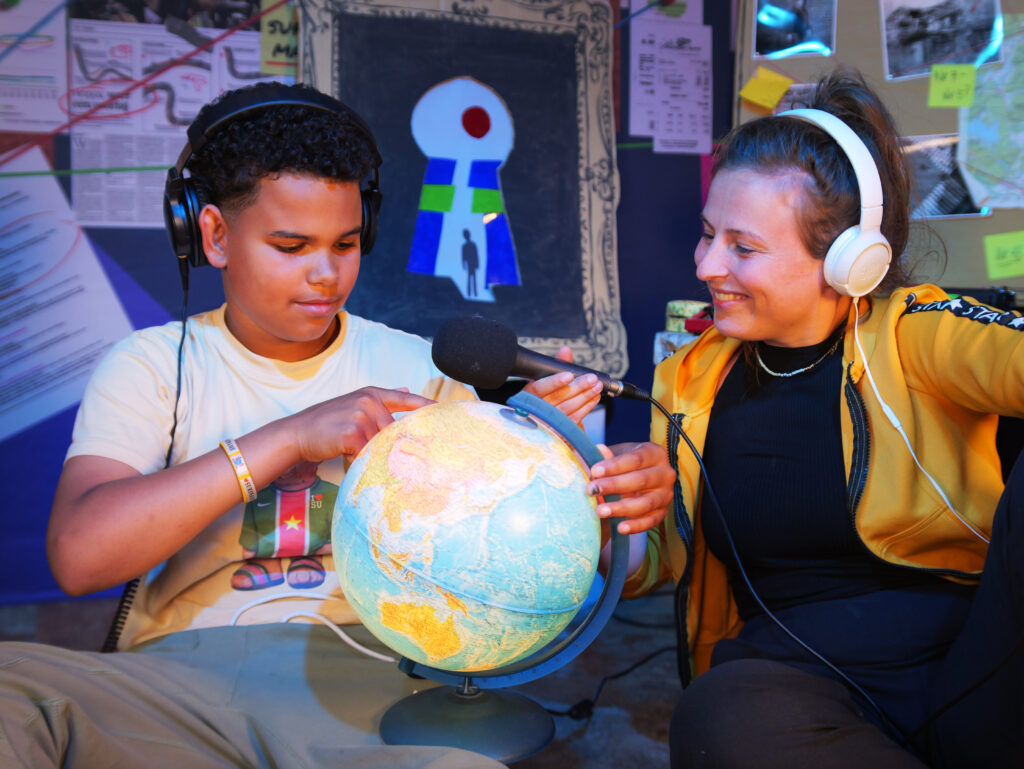
Ilaria: I tried to listen to some episodes, but for me it was quite difficult to completely understand because of the language. I understand you are the storyteller, the one who holds the thread of discourse and then there are all the materials you’ve collected with the children. Is this correct? Can you explain the structure of every episode and which is your role in the podcast?
Sara: I always start the episode with the reason why I decided to create this project, which is my own mystery that I have never been able to solve: my grandmother had a golden tooth in her closet and I always wanted to know what it was. Then there is an introduction of the child and a part where I go to see the protagonist with a small interview about the mystery. This is followed by the various steps to solve it. The episode is a kind of collage, so there is me and the child connecting all accompanied with sound design and music. There are often sections where we step back and I reflect on the theme inspired by the mystery, to broaden our point of view. Then I always come back to the main narration and listeners participate in some moments of the creative process, they can follow my journey in contact with the kid. So in the podcast, there is a line but I always go away from it. While that line is simple and it has a clear goal (we need to find a dog, for example) the reflections are quite deep and complex. What is important for me in every episode it’s to make sure everything is understandable and so it is crucial to create a clear bridge between the main line of the story, the considerations and the fantasy elements. Every episode then ends with a talk in which I reflect with the child on the bigger theme and after that, there is the song, which is always the same.
Ilaria: Has ever happened that a mystery could not be solved?
Sara: No, never, every mystery in my podcast must have a solution, even though the result is not amazing or extraordinary. If I am working on an unsolvable mystery, I change it. When you make something for children, I find really important to give a conclusion, especially if there is something to be solved because you give the child the opportunity to show him, or her, how any problem can have a solution. For example, there was an abandoned house and we really wanted to get inside to see if the thing the child thought about was still there: we were never allowed to enter because it was sold by a new owner. But it would be sad to end the episode by saying that we couldn’t get permission to enter, so I changed my point of view. The mystery became finding the history of this house and we discovered incredible facts, like that it was a place where in the Second World War Germans worked together. In the episode, I don’t neglect we started to want to get inside the house but we weren’t allowed; however, I tell listeners about the change and I lead them to follow the new path with us.
Ilaria: As you mentioned before, what you seek is to stimulate the imagination of both the child protagonist and the listeners. How do you do that, practically? What do you think audio allows for imagination that other media could not?
Sara: To stimulate the imagination I think it is important to have and to give a clear idea about the location where we are and what this place looks like. To do that in audio, you need to use a lot of details and visionary elements, in order to allow your listeners to create on their own the world you are telling. For this to happen it is necessary to repeat details often or point out details several times, because we are in the dark and it is necessary to show as much as possible. So, when you have a clear structure of the story, you help the audience to start imagining. About your second question, I think that with audio you can both create something that doesn’t exist in real life and make things cooler than they actually are. Of course, if you make cinema you have more money and you have sets and visual effects, however, you have to deal with the real world. In audio you can fantasize more because just with an echo you can narrate we are entering into a hole underground and allow the audience to visualize that. Also, with audio you can move fasterfrom one place to another. You can start talking about a general youth memory and then through music and sound design, you suddenly come to a personal youth memory. It is possible to live a dream, or memory and share it with others who can visualize in their minds those invisible situations.
Ilaria: What makes your podcast original is that it is a project aimed at younger listeners but it is at the same time created with children. So, how do you stimulate the imagination of the child you are working with for an episode?
Sara: Asking for anecdotes and memories. I find that, when people are telling stories their way, it’s their imagination that will answer your questions. I want them to come to their imagination spontaneously, and asking for stories helps. I don’t like to fill in the answer too much because when you do it, then they see you as an interviewer. For these reasons, I try to let them describe a lot, ask them how it smelled, what it looked like… I also used to help them fantasize, questioning: what would it look like? It is important to not have any opinion on their thoughts and stories, in order to let them know anything could be possible: how would you enter the house? I would try to creep, I would try to force the door open as they have created it in their fantasy or in their dreams.
Ilaria: In a way, it can be said that every narration is a sort of manipulation of reality. In your case, mysteries are real. Furthermore, I remember the episode I listened to at Lucia Festival , in which the protagonist was searching for the lullaby his dad used to sing to him when he was a baby, but he didn’t have contact with his father anymore. In the end, they met each other, so through your podcast, you change something in real life. How do you balance the relationship between reality and fantasy in your narration?
Sara: Of course, we follow real life, like in the episode you mentioned: the child had a dad but he lost contact with him and the mother didn’t want to reach him because the ex-husband had schizophrenia. What happened then was that he did contact me, because he found out I was working with his family. However, real-life has to become a story to tell in the podcast and I always try to make it the best possible. For this reason, sometimes I change something,. At the moment, for example, I am working with a kid who had a holiday friend that he wants to find back, but it would have been a mystery too easy to solve t since we found out quite fast that he was playing in a movie as an actor. So I ask the child if we could pretend we didn’t know that in the beginning, in order to have a more interesting mystery and story to tell. To give you another example: I met a kid who had a favorite doll and she had it for her whole life, but no one in her family knew who gifted the doll. I talked to her mother and she said that it could be from her great-grandfather, but he died. She told us that too soon, so I decided to forget t I knew that and I tried to find the mysterious gifter with the little girl. This is how I change reality, only a few details, never relevant facts.
On the other hand, recently I was afraid the child made it up because we were completely immersed in fantasy. She remembered a scary memory she experienced with a friend, so we tried to find him, but when it happened he said he didn’t remember anything. Probably, it was just a fantasy or a bad dream of the girl. In this case, there is much we can do e to create a good story.
Ilaria: How do the children react when they listen to their own episode?
Sara: It is cute and always funny. They feel strange when they hear their own voice, but what is most curious is that they don’t truly realize that we change small things. I remember a moment in the edit session, while the kid and I were listening to our episode in which we were scratching the mud away from a bent card, but in real life, that happened differently. However, the little girl thought it went exactly as she was listening. This is usual and it is funny because they have problems hearing their voice but they never doubt the reality of what they listen to.
Ilaria: So, it is like creating a different memory in their head. And when you finish the project with a child does the relationship continue?
Sara: I sometimes really miscalculate how important my meetings have been, mostly now when I have fifteen episodes already. However, I don’t really keep in touch with children even though I wish to. I tried that and I saw them waiting for days for me to come. It made me realize that I have a great impact on their lives, for just a little time, but then I suddenly disappear even though they shared intimate things with me. That makes me sad, but I can’t do it differently. On some occasions, I have come into contact with children because I find out that something has happened in their lives, such as the separation of their parents. So I really wish I could have a role in their lives, but it is difficult and probably not sustainable.
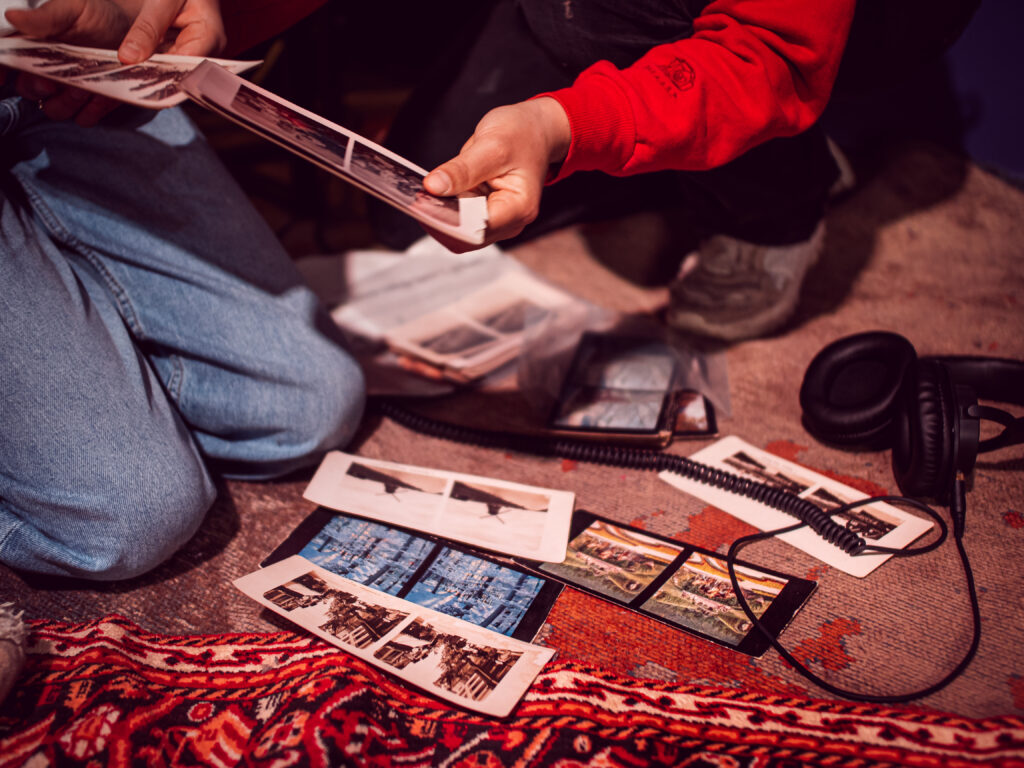
Ilaria: Our project Turn on your ears, explores the relationship between audio and theatre. You come from theatre and you make podcasts: could you say that theatre practice influences the way you think your audio works?
Sara: Yes for sure. A lot of my colleagues come from journalism and I see that they are really strict about the facts and about what is real and what is not. For me, however, it is more important the story and the imagination: in that way, I think it is clear I come from the art of theatre. I want to move my audience and grab the listeners, not just tell them a true story. So theatre influences me in the way I think about storytelling and about the rhythm, music, sounds…If you are a painter you want to have the most beautiful paintings and a perfect combination of technique and art: I think I love audio like a painter loves his painting. I want to reach a good audio quality and I use it not as a journalist but from an artistic perspective.
Ilaria: It is very interesting the comparison you made, saying that you work with audio as if you were a painter because we are talking about an invisible art. This perhaps confirms that the podcaster’s brush is imagination. You remind me of Claudio Morganti, an Italian theatre actor and radio drama maker, who one day said to me that theatre is something to be listened to and radio (or podcast) is something to be watched. So, talking about music and sound design: How important these things are to create a good story? Do you create them with children or alone?
Sara: No, children aren’t involved in this phase. I work a lot with sound design to create a world where listeners can dive into. I collaborate with a composer that composes new music for every episode of Sara’s Mysteries. I always talk to him about the theme and the atmosphere I want to create. For example, one episode had to do with writing and sending letters, so I asked for music that took from real sounds – like mailbox, a pencil… – and became something else. I always ask to mix real sound with music.
Ilaria: Sara’s Mysteries is also a live performance. Why bring it to the stage and how does this change the experience?
Sara: As a theatre maker, it is hard to put your creation online and know that thousands of kids are listening to it but you don’t see their faces and their reactions. For this reason, I decided to have a live show, structured in two parts. In the first one, the children listen together to an episode of the series, in which there is quite often a small cliff-hanger, then kids can think what they would do to solve the mystery. It is interactive because I discuss with the audience about the big theme and I ask about their feelings about what they listened to. In the second part, there are at least three children from the audience and one at a time they come on stage to solve their mystery. I add music themes and sound effects during the performance, to create a big world and I connect all of them. Sometimes we might need the help from another audience member, so we invite someone – even a parent or another adult – to come on stage. We might need a character, so we ask “who wants to do it?” or someone to play the sound machine on stage. The result is very engaging. I then come on stage with many stories in my head, to guide both the child and the audience.
Ilaria: A strange question for you: is there a mystery that Sara – or the little Sara in you – would like to solve (or has solved)?
Sara: When I was a child and my parents had just divorced. I suspected that my father had a new lover, but I wasn’t sure he really wanted to say something about it. So I wanted to go to his house to check his dishwasher and see how many plates there were in it. This was a big mystery for me when I was a kid and I really tried to find clues: I literally checked the bathroom, the trash, to see if there was woman’s stuff. My father didn’t know I was being so curious about his love life. This also shows how many mysteries kids have they don’t tell their parents.
Ilaria: Do you think you will ever solve it?
Sara: I actually solved it, there was a woman in his life and he remarried. But I remember I was really curious about love and it was a big thing in my growing-up stuff.
Ilaria: Do you have any new projects you are working on?
Sara: I am working on a growing-up version of Sara’s Mysteries, for adults from twenty years old, which is going to be very interesting because mysteries are more personal and less crazy like getting into an abandoned house to see if there is something. At the moment, it is harder than with children, because mysteries are more complex and difficult to solve. But it will be a good adventure!
A scuola con Walter Benjamin e la sua radio
di Rodolfo Sacchettini
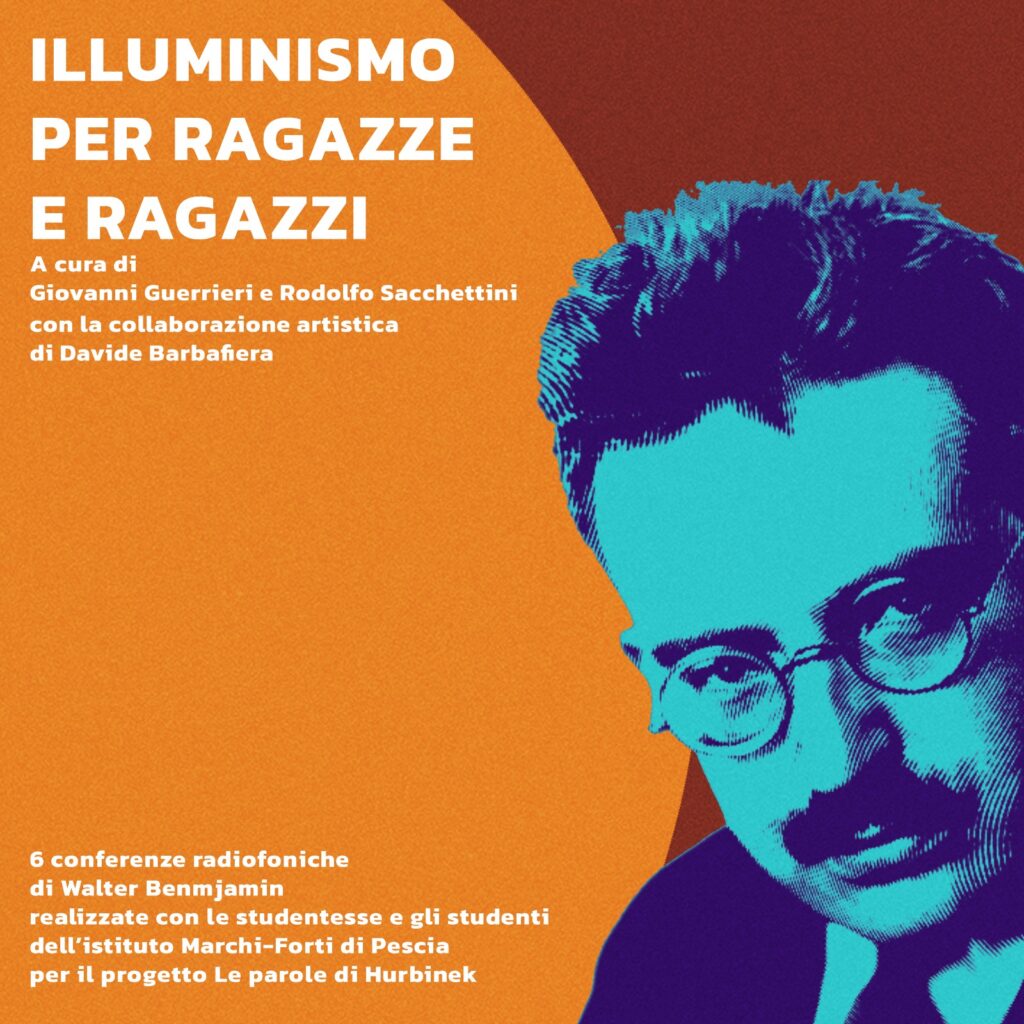
Partiamo dalla fine. La storia di Walter Benjamin si conclude nel modo peggiore. Lui, intellettuale ebreo, era fuggito dalla Germania dopo l’avvento del Nazismo e si era stabilito a Parigi. Con la disfatta della Francia, cerca di fuggire negli Stati Uniti, ma alla frontiera spagnola è bloccato e gli viene ritirato il visto di transito. La Gestapo lo sta inseguendo ed è a pochi chilometri di distanza. La notte del 25 settembre 1940, in attesa che la polizia di frontiera lo lasci passare, permettendogli così di imbarcarsi per l’America, Benjamin viene travolto dal panico e si suicida con una overdose di morfina. Questa è la fine tragica della storia. E siamo partiti da qui, io e Giovanni Guerrieri della compagnia dei Sacchi di Sabbia con la collaborazione di Davide Barbafiera, per fare un viaggio ancora più indietro nel tempo, insieme agli studenti della IIIA e IIIB dell’Istituto tecnico Marchi-Forti di Pescia e ai docenti Roberto Torre e Massimo Vitulano, per rievocare Walter Benjamin poco prima della fuga della Germania. Quando tutto si sta mettendo per il verso sbagliato. Ma ancora è possibile fare qualcosa. Tra il 1929 e il 1932 Benjamin comincia, anche per guadagnare qualche soldo, a collaborare con la radio di Francoforte, scrivendo un’ottantina di testi. Sono per la precisione “conferenze radiofoniche” rivolte alla gioventù tedesca, cioè ai ragazzini e alle ragazzine dai dieci anni in su. Che cosa raccontare ai giovani tedeschi, un attimo prima dell’ascesa del Nazismo? Mentre la Germania è sempre di più avvolta in un clima di violenza, quali sono le storie importanti da narrare e i valori da trasmettere? Un attimo prima della catastrofe, un attimo prima di quando i microfoni – e i giornali e tutti i mezzi di comunicazione e tutte le istituzioni educative – verranno negati agli ebrei e alle persone non perfettamente allineate al regime totalitario?
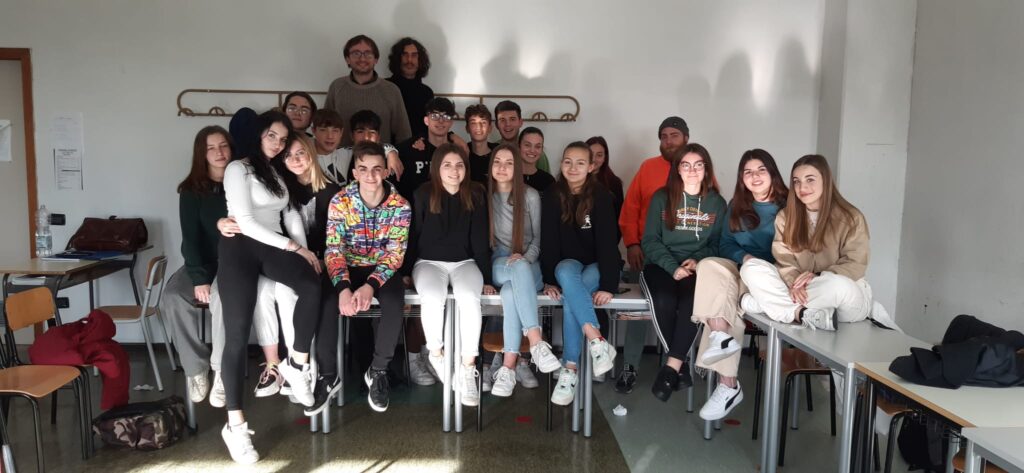
Questo laboratorio, realizzato all’interno del progetto Le parole di Hurbinek, ideato e diretto da Massimo Bucciantini a Pistoia per la Giornata della Memoria (dal 18 al 23 gennaio 2023), è servito per leggere assieme, discutere e registrare sei conferenze radiofoniche di Benjamin. Fin dall’inizio delle trasmissioni della radio tedesca molti intellettuali, da Benjamin a Brecht, credono che il nuovo mezzo di comunicazione possa essere utilissimo per l’educazione dei più giovani, anche se è ritenuto ancora uno strumento «antidiluviano», perché fatica a creare una necessaria forma dialogica tra chi parla e chi ascolta. Bisogna trovare la forma giusta. La famosa distinzione della BBC in tre canali per adempiere a tre funzioni diverse ma tutte essenziali, cioè informare, intrattenere ed educare -non convince i tedeschi che, per una società senza classi, vorrebbero ribaltare i piani: la cultura deve intrattenere e l’intrattenimento educare. Benjamin costruisce delle micronarrazioni, delle miniature radiofoniche (della durata di massimo venti minuti), dei racconti che hanno il sapere della parabola. Non sono testi facili e neppure rassicuranti, al contrario le conferenze radiofoniche si pongono come immersioni gentili in alcuni episodi della Storia che, con il trascorrere dei minuti, svelano una loro compiutezza, per risolversi non tanto in una morale, ma in una questione, una domanda, un dubbio, un cambio di prospettiva. Nella scelta delle conferenze abbiamo privilegiato i grandi temi affrontati da Benjamin, a partire dal confronto con personaggi reali o leggendari avvolti nel mistero e spesso svelati nella loro natura di imbroglioni (Cagliostro, Faust…). In secondo luogo abbiamo individuato il tema della catastrofe naturale o tecnologica, perché è un elemento essenziale per capire la corsa allo sviluppo dell’umanità. La luce della ragione non può rendere ciechi, il progresso umano è una costellazione di catastrofi, che servono a ridimensionare la potenza umana, a ricordarci dei limiti naturali e culturali. Infine abbiamo selezionato le conferenze dove si manifesta lo spirito critico che cerca di mettere in discussione stereotipi, pregiudizi, posizioni arbitrarie. Tra queste colpisce la conferenza dedicata al carcere. Come è organizzato il sistema punitivo rivela tanto di come è strutturato il potere. Benjamin descrive minuziosamente il modo di gestire le punizioni e la vita dei condannati all’interno della Bastiglia, il carcere occupato durante la Rivoluzione Francese e che diventa il simbolo della libertà. Perché la Bastiglia rappresentava il potere dell’Ancien Régime. Era un carcere al servizio del Potere, anziché del diritto. Ci ricorda Benjamin che a volte persino la crudeltà e la durezza sono sopportabili agli uomini, se essi sentono che sono sorrette da un’idea di giustizia. Altrimenti è solo Potere. Per questo la presa della Bastiglia segna una svolta non soltanto nella storia della vita politica dei francesi, ma anche in quella della loro vita giuridica. Dare voce alle parole di Benjamin, in modo corale e condiviso, con piccole drammatizzazione, diventa così un modo di lettura, ascolto, comprensione ed espressione.
Dentro e fuori la scuola: educare all’ascolto con radio e radiodrammi
di Agnese Doria
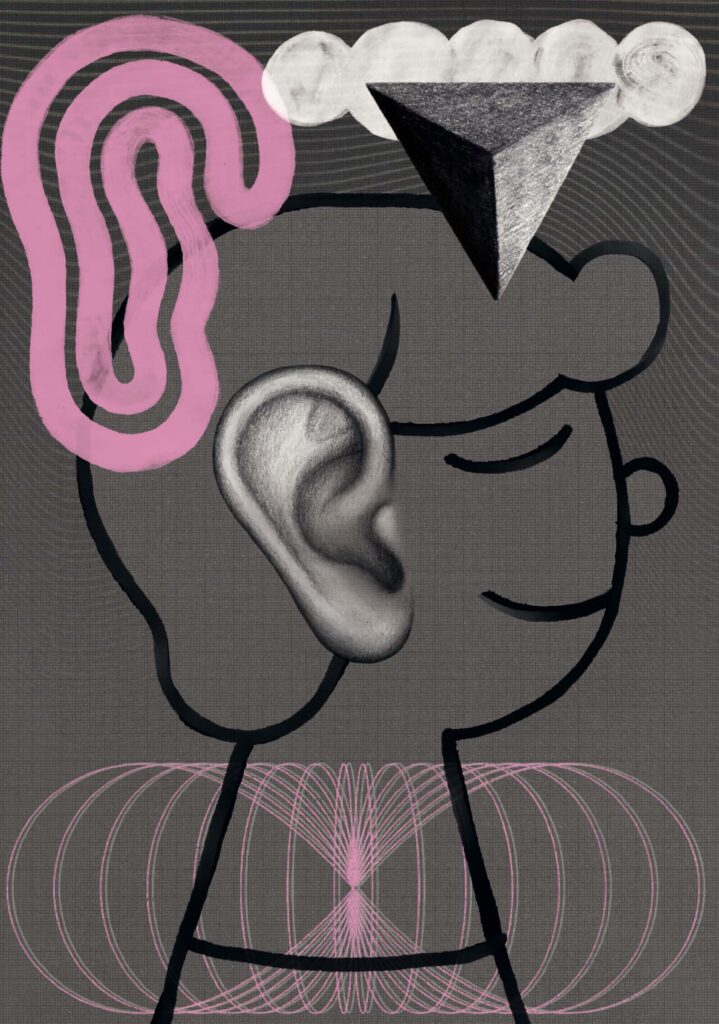
Talk radio, radio live, interviste audio, collaborazioni con web radio sono da sempre presenti nel lavoro di Altre Velocità fin dai primissimi anni di attività. Quando abbiamo iniziato a incontrare gli studenti delle scuole, non ha tardato quindi a fare capolino una modalità di cattura e deposito della voce che, soprattutto nell’orizzonte legato all’infanzia, ci pareva potesse restituire quel senso di meraviglia a cui dovrebbe sempre allenarci il teatro. Ciò che leggerete di seguito è un racconto, diviso in brevi capitoli, delle modalità che abbiamo immaginato per intrecciare l’educazione all’ascolto e registrazione audio, avendo come collante il teatro e le nostre esperienze di visione insieme alle nuove generazioni.
Un cuore caldo in modalità di scatto: il teatro raccontato dalla viva voce di bambini e bambine
Nel corso dell’anno scolastico 2016/2017 Altre Velocità ha iniziato a portare per la prima volta in maniera strutturata il progetto Crescere Spettatori nella scuola primaria. In alcune classi selezionate abbiamo condotto uno dei nostri percorsi di educazione allo sguardo (con incontri che precedono e seguono la visione di uno spettacolo), ma abbiamo inserito la anche la registrazione: desideravamo restituire quella vita che fiorisce dopo che un essere umano incontra il teatro. Acciuffare le voci e i pensieri nel loro farsi è l’istantanea sfocata di un’incandescenza; Non la fotografia immobile di un deposito scritto di pensieri, quanto la vita sfuggente di un pensiero che ci parla molto anche della natura del teatro stesso: il sipario si chiude ma il teatro non esaurisce la propria portata, continua a interrogarci e a porci domande e, nella migliore delle ipotesi, anche noi continuiamo a interrogare quell’opera.
Avremmo potuto decidere di far scrivere i bambini, come spesso facciamo con i preadolescenti e gli adolescenti, ma catturare la loro voce nel momento in cui costruisce un pensiero, acchiappare un ragionamento complesso nel suo farsi, ha qualcosa di grandioso e potente, vibrante e stupefacente. Abbiamo inoltre cercato valorizzare la riflessione individuale nel momento in cui diventa patrimonio di una piccola collettività, come la classe. Ne è nato un CD (con la collaborazione di Francesca Bini e Rodolfo Sacchettini), oggetto ormai desueto e dal retrogusto vintage, che – ci riportano le famiglie – è diventato per i bambini e le bambine un oggetto feticcio da ascoltare per riascoltarsi nella propria cameretta, e da infliggere ai familiari nei tragitti in auto. Queste voci raccolte sono state il, primordiale tentativo, di valorizzare e dare corpo al proprio pensiero verso una pratica di sguardo consapevole e critico.
Occhio alla radio: un modo per raccontare il teatro
Negli anni successivi sono stati tanti i tentativi di proseguire questa traiettoria dentro e fuori le classi: ci sono stati gli anni di Occhio alla radio (2019, 2020, 2021) progetto nato in collaborazione con SalaBorsa / Officinadolescenti (Bologna), e con Rodolfo Sacchettini, Lucia Oliva e Fungo di educazione allo sguardo in cui una redazione radiofonica composta da adolescenti sono stati chiamati a raccontare l’esperienza di visione tramite racconti e formati audio. Il teatro, gli aspetti più prettamente giornalistici (l’intervista, l’approfondimento, la recensione, l’inchiesta) e la conduzione radiofonica (l’uso della voce, la modulazione delle pause e del tempo della conduzione, l’uso dell’inframmezzo musicale, la creazione di un jingle) sono stati gli attivatori di una forma aggregativa potente. Andare a teatro in orario serale al di fuori della famiglia o della scuola, vivendo la notte, la città e le offerte culturali in modo più consapevole – e al tempo stesso libero – sono state le cornici per una palestra di educazione allo sguardo che, attraverso il dialogo, ha fornito un avvicinamento alle arti sceniche contemporanee per comprenderne i linguaggi, i temi e le domande rivolte al giovane spettatore. Per noi era fondamentale arrivare al mezzo radiofonico facendolo passare attraverso le maglie del teatro: quel che abbiamo chiesto ai ai più giovani è stato lo sforzo di prendere parola dopo una pratica condivisa di analisi di uno spettacolo, provando a cercare la propria voce e il proprio posizionamento di fronte a quell’oggetto artistico.
Occhio alla radio: Ascolta “OAR -Puntata 04 – Kobane calling on stage” su Spreaker. – Con intervista a Zero Calcare
«Riponete nello zaino quaderni e astucci». Perché ci ostiniamo a parlare di radiodramma
A partire dal 2020, per rispondere al mutato contesto pandemico durante il quale i teatri erano chiusi, abbiamo provato (io, Lucia Oliva e Beatrice Baruffini) a osservare il reale entrandoci in relazione, rendendo i confini del nostro fare quotidiano malleabili, plasmabili, senza perdere la radicalità della nostra identità. Al di là delle retoriche sulla pandemia come opportunità, il contesto ormai cambiato ci ha offerto tante domande, molte delle quali nuove e ancora inesplorate. Portare nelle classi una forma di educazione all’ascolto grazie all’ascolto di radiodrammi con i radiodrammi, ci ha permesso di mantenere un contatto con le grandi domande del teatro, provando a fare buio, ricontattare se stessi, Quello che abbiamo notato è che radio e l’opera teatrale radiofonica raccontano a questi giovanissimi di un tempo lontano, che ai loro occhi diventa quasi esotico, mitologico. L’impressione è che la forma radiofonica, il sonoro e l’audio abbiano toccato nel profondo e che qualcosa si sia risvegliato. Quel risveglio l’abbiamo percepito negli occhi attenti, nei micromovimenti delle pupille che cercavano, “vedevano” ciò che ascoltavano. Ho compreso, scossa da brividi, che il teatro si era manifestato ai loro occhi quando hanno applaudito alla fine dell’ascolto. Li abbiamo osservati, indugiando, mentre ascoltavano: ho scrutato le loro posture, le pause nelle loro azioni, i momenti di quiete, i movimenti interiori che arrivavano alla risata e manifestavano così la loro immersione in quella storia. Cosa ha significato portare nei contesti scolastici un laboratorio di ascolto? Cosa ha significato chiedere ai giovani e giovanissimi di ascoltare solamente senza avere nulla da vedere? Cosa ci hanno detto i radiodrammi di diverso da quello che ci avrebbe raccontato un podcast?
Avendo l’occasione di portare il progetto alle elementari, alle medie e alle superiori e in contesti scolastici estremamente eterogenei da svariati punti di vista (diversità economiche, sociali e culturali) abbiamo potuto notare l’impatto che la richiesta di immaginare aveva sui ragazzi: alcuni, soprattutto adolescenti, hanno riportato una difficoltà nell’immaginazione, nell’immersione in assenza di una visione a cui aggrapparsi. L’elemento visivo è preponderante nella società dell’immagine e l’immaginazione non è ritenuta, nei contesti scolastici, una soft skills capace di aprire varchi nel sapere istituzionale o nella possibilità di costruire percorsi autonomi.
Ascoltare in classe, insieme, un radiodramma è stata l’occasione per cambiare il paradigma di ascolto intimo, in cuffia, che i ragazzi frequentano quotidianamente. L’ascolto collettivo diventa un’azione sociale capace al tempo stesso di connetterci a noi stessi e alle reazioni dell’altro da sée, condividendo quella che a pieno diritto diventa un’esperienza della classe. Portare una primissima azione di “educazione all’ascolto” a scuola ci è parsa fin da subito una sfida inderogabile. Un modo per proporre alla comunità educante uno strumento di analisi attraverso un’esperienza diretta. La scuola è un luogo dove ci sono le condizioni per ascoltare e ascoltare se stessi? La comunità scolastica sa ascoltarsi reciprocamente? Quali sono gli ingredienti imprescindibili per un “buon ascolto”? Quale senso sociale, politico, storico affido all’esercizio dell’ascolto? Possono le risposte che ci diamo a queste domande rientrare tra gli orizzonti educativi di una scuola pubblica?
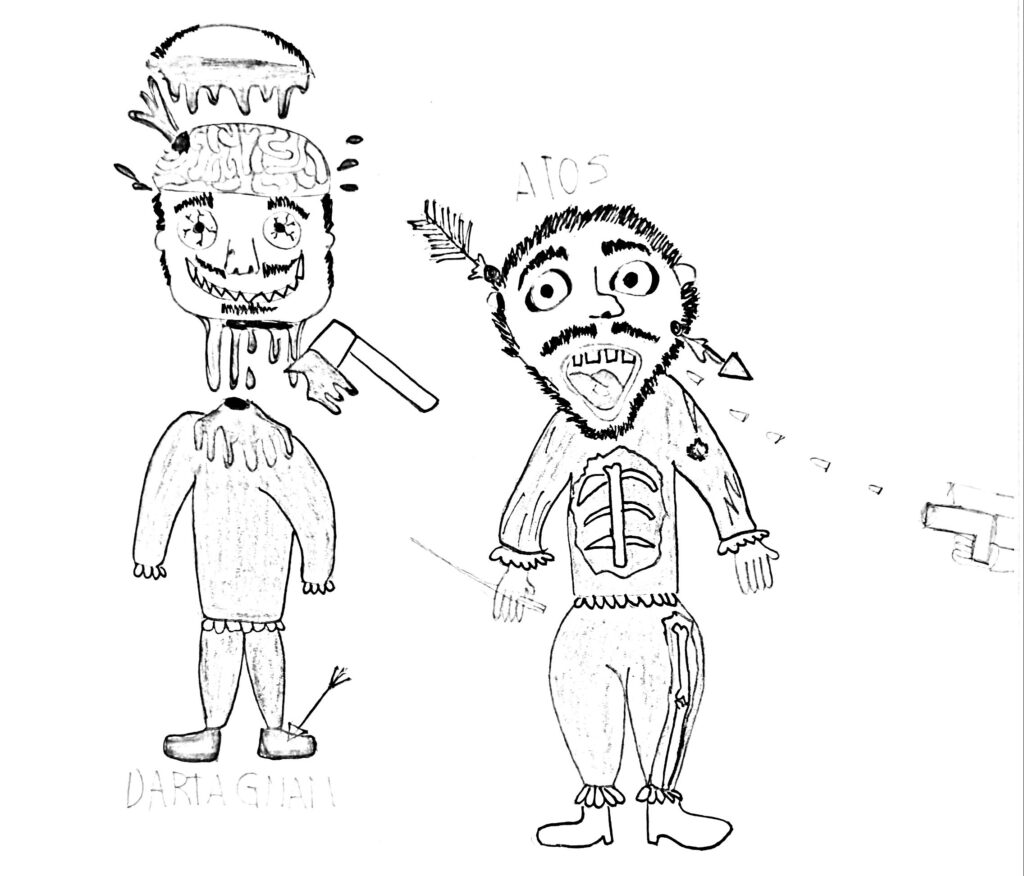
Il non fare come stile educativo
Nel nostro percorso di educazione all’ascolto ci piaceva proporre incontri che non producessero nulla, da cui si potesse uscire senza avere niente di materiale in mano: Non abbiamo nulla in contrario a quella pedagogia “del fare” che da Freinet a Don Milani, da Mario Lodi fino a Munari ha reso quotidiana e condivisa la frase «chi ascolta dimentica, chi vede ricorda, chi fa impara» e che ha contribuito a cambiare il modo di intendere l’educazione. Ma siamo molto vigili quando la usiamo, consapevoli dello scacco culturale che si può generare: il laboratorio con un esito è più facilmente fruibile, ma questo non dovrebbe scivolare nella facile considerazione che sia quindi anche più utile. Il fatto di verificare immediatamente un risultato non motiva necessariamente l’utilità della proposta. Invece il tempo dell’ascolto mi fa sostare nella fatica dell’attesa, mi insegna a stare dentro alla frustrazione del buio, ad ascoltare le parole di un autore, magari distante da me nello spazio e nel tempo.
Se per i ragazzi di Don Milani lo sforzo era di procurarsi le parole necessarie per farsi riconoscere il diritto a una presa di parola, oggi per molti lo sforzo sta nel frenare un desiderio di intervenire sempre e comunque. Si potrebbe azzardare forse che il desiderio di partecipazione promosso dalla pedagogia del fare si è, nel corso dei decenni, mutato in bisogno di protagonismo. Questo bisogno trova terreno fertile nella retorica del protagonismo giovanile, che potrebbe tendere delle trappole se non la si affronta cum grano salis.
In conclusione, alfabetizzare all’ascolto
I progetti “sonori” condotti nelle scuole ci hanno permesso di far emergere l’invisibile che si muove nei più giovani. Ascoltare è sempre un ascoltarsi, attitudine che sarebbe opportuno esercitare nella società dell’individualismo sfrenato e che dovrebbe venire prima di una presa di parola consapevole e ponderata, in un contesto plurale e collettivo come quello delle classi. Siamo consapevoli che nuovi orizzonti si potrebbero percorrere anche a partire da tutti quei giovani con bisogni educativi speciali, che magari faticano nella lettura e potrebbero trovare nell’audio un agio e una piacevolezza capaci di includerli in un nuovo modo di fare scuola. Inoltre l’ascolto prevede un allenamento e un ampliamento della propria personale soglia di attenzione e si rivela, in questo, un valido alleato come pochi altri strumenti didattici; potrebbe, infine, rappresentare una vera e propria alfabetizzazione nei confronti dei NAI (nuovi arrivati in Italia), che grazie alla narrazione sonora potrebbero essere sorretti nella loro personale comprensione.
Per approfondire – I consigli di Altre Velocità
Ascolti:
La radio per le scuole Archivi – Rai TecheRai Teche: Trasmissione storica della RAI dedicata ai più giovani
Locomoctavia – Audiolibri: gruppo di produzione di audiolibri e storie sonore per bambini/e
Lettura:
R. Sacchettini, Radiogenie / Quando la radio faceva scuola, doppiozero.com, 12 Aprile 2020
M.V. Alfieri, La scuola in ascolto – Le potenzialità dei podcast nell’education, dalla Newsletter “Questioni d’orecchio” di Andrea De Cesco
AF – Altre frequenze è una delle azioni di Turn on your ears, progetto a cura di Altre Velocità, sostenuto dalla Regione Emilia-Romagna, dal Comune di Bologna e dal Ministero della Cultura.
Gli autori
-

Critico teatrale, è tra i fondatori di Altre Velocità e collabora con la rivista Gli Asini. Dal 2004 conduce una rubrica radiofonica di attualità teatrale su Rete Toscana Classica. Ha curato svariate pubblicazioni nell'ambito del teatro ed è stato codirettore del Festival di Santarcangelo per il triennio 2012-2014 e presidente dell'Associazione Teatrale Pistoiese.
-
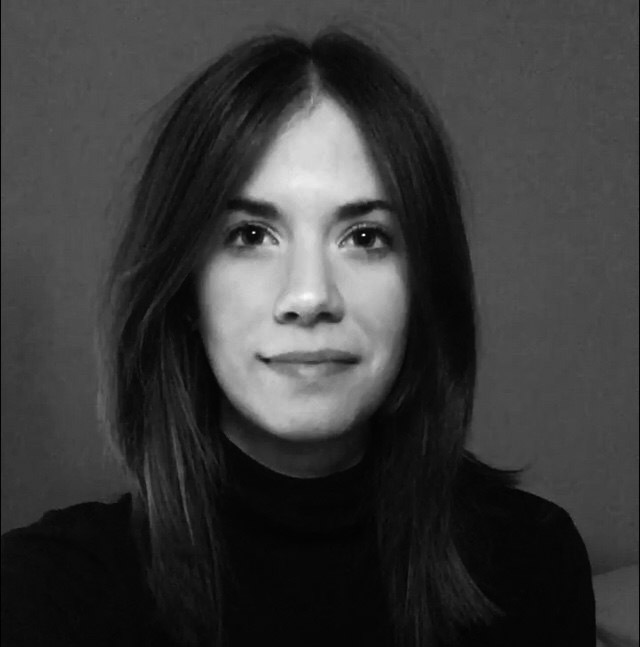
Laureata in Dams e in Italianistica, si occupa di giornalismo e cura progetti di studio sul rapporto tra audio, radio e teatro. Ha collaborato con Radio Città Fujiko ed è audio editor per radio e associazioni. Nel 2018 ha vinto il bando di ricerca Biennale ASAC e nel 2020 ha co-curato il radio-documentario "La scena invisibile - Franco Visioli" per RSI.
-
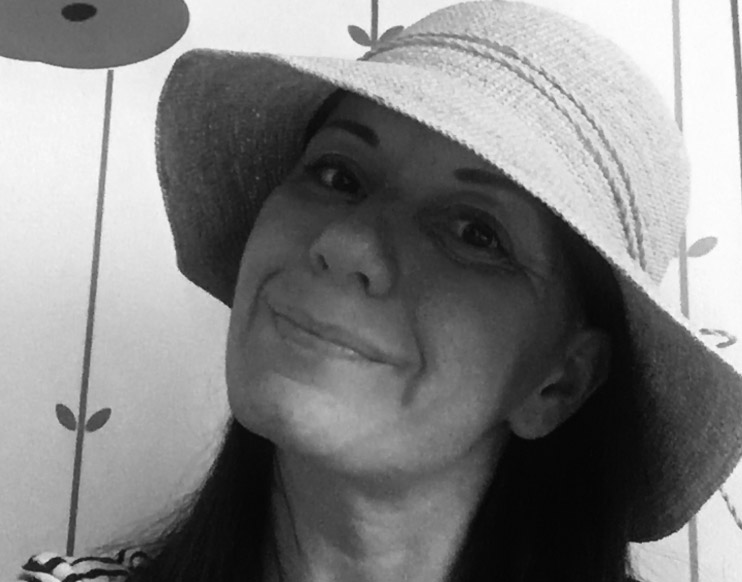
Classe 78, veneta di nascita e bolognese d’adozione, si laurea in lettere e filosofia al Dams Teatro e per alcuni anni insegna nelle scuole d'infanzia di Bologna e provincia e lavora a Milano nella redazione di Ubulibri diretta da Franco Quadri. Dal 2007 è giornalista iscritta all’ordine dell’Emilia-Romagna. Ha collaborato con La Repubblica Bologna e l’Unità Emilia-Romagna scrivendo di teatro e con radio Città del Capo.

